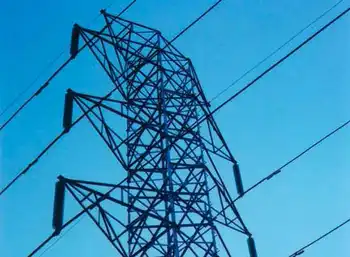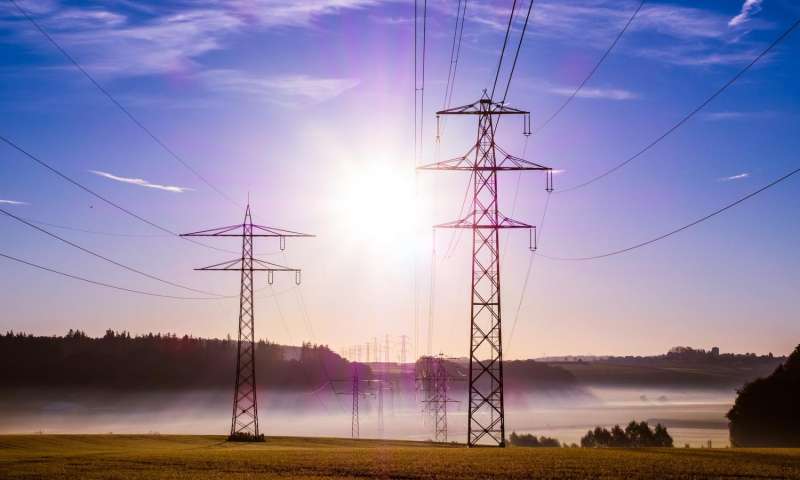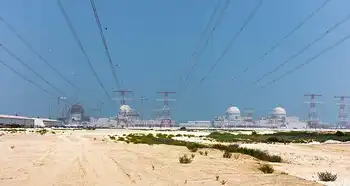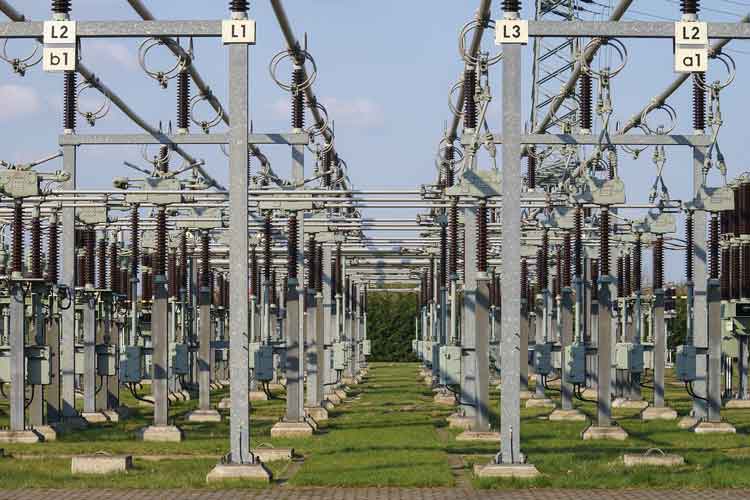When the wind blows
- History will be made soon when the blades begin to turn on Britain's first major offshore wind farm.
Fortunately the winds are light on the day we venture out to see the wind turbines. The waters off Rhyl's dilapidated seaside promenade are calm and our boat throws itself forward noisily for most of the short journey. But as we get within a few hundred metres of the windmills, the captain cuts the throttle and everything is silent. Floating gently between the great towers, the only sounds come when an occasional wave hits one of the windmills' bright yellow foundations.
From the Welsh coastline, these windmills looked like nothing more than a ragged line of matchsticks on the horizon, somehow managing to stand firm in the cold, dark water. Seven kilometres out into the Irish Sea and up close, the steel grey windmills take on a very different character: serene and impossibly tall, their enormous blades stretch out above you like giant arms holding up the clear blue sky.
Soon these great arms will begin to turn and Britain's biggest renewable energy power station will start generating electricity. North Hoyle offshore wind farm, with its impressive array of 30 windmills, will feed up to 60 megawatts (MW) of power directly into the national grid.
North Hoyle is the first major offshore wind farm to be built in British waters, but 16 further offshore wind farms have now been given the green light, and some of them are already nearing completion. By 2005, we will have more than 500 offshore windmills, between them generating more than 1,000MW of power - equivalent to one large coal-fired power station -enough to power almost 1m homes.
The government is committed to cutting the UK's carbon dioxide emissions by 60% by 2050, which means getting serious about renewables, and of all those technologies, wind power is by far the best-developed for large-scale energy production. Of course it helps that there is a lot of wind blowing around these islands.
"The UK has the best wind resource in Europe," says Michael Rea, director of strategy at the Carbon Trust, a government-funded company that looks at ways of redressing some of the predicted problems of climate change.
Around 40% of the wind that blows across mainland Europe crosses the UK, he says, and, if we could somehow harness and store it all, it would be enough to provide power for the country three times over.
Building offshore means that winds tend to be stronger and more consistent with no buildings, trees or other structures to get in the way. "Because we have a lot of relatively shallow seas around us, offshore winds certainly should be able to provide a good chunk of [our] energy," says David Kerr, a member of the energy board at the Institution of Civil Engineers.
Maintenance might seem to be a problem, but the people behind North Hoyle say that the long term costs of maintaining windmills are low. Once the farm is up and running it will only need periodic servicing to make sure things are in working order. The 7 tonne fibreglass blades and the power-generating turbines have been specifically designed, the makers say, to survive the ravages of the corroding weather out at sea for the best part of 20 years - theoretically without the need for any replacement parts.
Not that building wind farms is a straightforward business, even at sea. They may be more popular with the locals than landbound windmills (which are often dismissed as "eyesores", and can be noisy), but that's not necessarily saying much.
Mike Carter, project manager for North Hoyle, admits that locals in Rhyl were unhappy when they saw the first of the windmills being installed, although they've since come round to the idea. Fortunately, the Campaign to Protect Rural England (CPRE), which is anti anything that might spoil a pretty landscape, seems to be more sympathetic to offshore farms, especially as they will normally be built too far from land to be visible except on the clearest of days.
As he steers our boat through the farm at North Hoyle, captain Nick Longfield says the intent is for the offshore wind farm to be very much a part of the local community, to the extent that none of it is off limits. As it stands, anyone can turn up at the windmills and get as close as they want. Even climbing on to the structures is allowed - although, unsurprisingly, you can't very high up and it is discouraged except in emergencies. "We're mindful that if these technologies are to be taken up much more widely, you've got to set up a situation whereby local communities are comfortable with these developments in their midst," says Merylyn Hedger, a climate change policy manager at the Environment Agency.
The Royal Society for the Protection of Birds remains worried that there could be carnage if flocks of migrating birds fly headlong into the blades. But Longfield is already working with scientists to try to find out how the windmills might actually be affecting the local wildlife. Our boat, it turns out, is a vital part of his work. Bristling with the latest sonar and imaging technology, it will help scientists in surveying the populations and movements of local animals.
There are already some positive results. Longfield says that the underwater sections of the towers have created new habitats for shellfish and other marine life. The vibrations on the sea floor, caused by the turbines, also attract fish, he says.
There are a few problems with offshore wind farms, however, that may prove tricky to overcome in the long term. How to plug them into the UK's electrical grid, for example. The national grid was designed to transfer the energy generated in huge power stations in central areas of the country out to its edges. But by the very nature of where many renewable energy power sources will have to be sited (essentially in or next to the sea), this relay pattern will have to be reversed. "At least in the short to medium term, it's quite a serious problem," says Kerr. "The grid is generally fairly weak around the coast."
In order to connect an offshore wind farm to the grid, substantial new cables must be installed between it and the nearest power substation. Kerr says, however, that that substation may not be capable of handling the amount of electricity coming into it from the wind farm, or that the cables linking it with the next substation may not be good enough. "You've got to possibly upgrade for some way inland," he says.
The problem will not affect farms like North Hoyle because they will be relatively small. But the government is planning a second round of far larger offshore farms (due to open later this decade). These are likely to have up to 200 turbines per farm and each will produce up to 1,000MW of electricity.
"That grid problem has to be solved fairly quickly if offshore wind is going to take off," says Kerr. If these problems are overcome, though, wind farms (including the landlocked variety) could be generating 8% of Britain's total power needs by 2010. The vast majority of that will come from offshore windmills.
But there is one more, rather obvious, problem with wind power.
"The wind doesn't blow all the time," says Kerr. "Most wind farms on land are generating for typically a third of the time.
"Offshore, the figure's likely to be a bit higher but it's never likely to be above about 40% of the time. If you get a high pressure in winter, you can have a period of two weeks when the temperatures are all below zero and there is no wind. You can't rely solely on wind power."
The Carbon Trust comes to the same conclusion. "You need a combination of lots of energy efficiency and lots of renewables," says Rea. "We would advocate taking forward a portfolio of renewable technology."
Wind farms are established in the English countryside, but they could soon become part of our towns and cities as well. On the site of the old Ford motor works in Dagenham, east London, projects to build three giant wind turbines - the first of their kind inside the M25 - have recently been granted planning permission.
When it opened in 1929, the works was powered by nothing more sophisticated than burning rubbish, and smoke from more than 1,000 tons of London refuse polluted the skies every day. Visiting in the 1930s, George Orwell saw the site as "a vast new wasteland of glass and brick".
Although the car assembly plant, once the largest in the world, is now gone, the Dagenham estate remains a bleak industrial landscape littered with pylons and power lines and the large open spaces where they used to store the cars. To this day, the Dagenham estate is an expanse of white space on the London A-Z.
Across the ashes of industrial decay blow winds of change. Rising over the former car factory, three Enercon E66 wind turbines, designed by Sir Norman Foster, will be built by Ford in early 2004. The tallest will stand 85m high (121m if you include the span of the blades) while another will house a viewing platform open to the public. With its height and spectacular views of the river Thames, some are already calling it the Essex Eye.
The turbines will produce enough energy to power Ford's new diesel design centre, a state-of-the-art research and development facility opened by the prime minister, Tony Blair, earlier this month. Even the light industrial units that cluster around the design centre like gulls round the end of a pier will be able to make use of the extra wind power on windy days.
Unlike earlier generations, the Enercon turbines are incredibly quiet. They create virtually no mechanical noise and the only thing audible is the passage of air over the blades. This is what makes them suitable for cities. Their main problem is "shadow flicker" - the effect of the sun shining at a low angle through the moving blades, which means they might have to be shut off at sunset and sunrise if built near houses.
Over in west London, Hammersmith council has shelved a project to build an Enercon E66 turbine on a site adjoining Wormwood Scrubs. It was believed the scheme would fail at the planning stage. In stead the council has been introduced to a possibly more ambitious scheme to install smaller wind turbines on the roofs of its tower blocks. The first, on a 22-storey residential block near Shepherds Bush, will begin in January.
"It's all right having wind farms stuck out at sea, they can supply the coastal areas, but there's no way we in Hammersmith can start putting generators offshore," says Ed Parry, energy manager for Hammersmith and chair of the London boroughs energy management group. "I believe that we also have to take some responsibility ourselves. We can't just put [wind turbines] up in someone else's area."
These smaller turbines, capable of supplying 15 homes, do not need planning permission and Parry says each tower block could support several turbines. They cost £30,000 each but advocates say they can pay for themselves in less than 10 years. The return on an Enercon turbine is even greater. Although they cost approximately £1.25m, experts say they can pay for themselves in 4-5 years.
Alex Felton of Renewable Energy Solutions, an Eastender who made a small fortune from asbestos clearance before switching into renewables in the 1980s, dreamed up the Hammersmith project. "The payback to the environment is immediate," he says. "The quicker we start installing these turbines, the quicker we can stop putting CO2 emmissions into the atmosphere."
Meanwhile BP is experimenting with two wind-powered petrol stations in central London, while Sainsbury's powers its delivery depot in East Kilbride with giant turbines. Other cities, such as Amsterdam and Copenhagen, are also beginning to build wind parks on the outskirts.
Part of the appeal is cheaper energy. Although wind speeds in cities (even at a height of 85m) cannot match those offshore, there is less transmission loss if power is generated close to where it will be used.
Related News
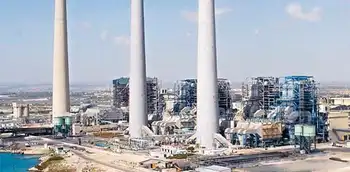
Will Israeli power supply competition bring cheaper electricity?
TEL AVIV - "See the pseudo-reform in the electricity sector: no lower prices, no opening the market to competition, and no choice of electricity suppliers, with a high rate for consumers despite natural gas." This is an advertisement by the Private Power Producers Forum that is appearing everywhere: Facebook, the Internet, billboards, and the press.
Is it possible that the biggest reform in the economy with a cost estimated by Israel Electric Corporation (IEC) (TASE: ELEC.B22) at NIS 7 billion is really a pseudo-reform? In contrast to the assertions by the private electricity producers, who are supposedly worried about our wallets…

